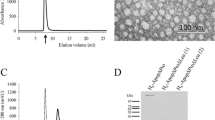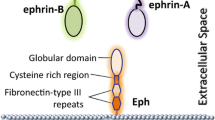Abstract
Fibroblast growth factors (FGFs) have been implicated in a number of proliferative lesions, including malignant tumor growth and vascularization. As a result, cytotoxic agents that target cell surface FGF receptors are currently under investigation. Previous reports have shown that conjugation of basic FGF with the ribosome inactivator, saporin, results in a potent cytotoxin specific for cells bearing high-affinity FGF receptors. In this report, we have used this FGF receptor-dependent cytotoxin to study receptor interactions at the surface of embryonal carcinoma cells, which express low numbers of high-affinity FGF receptors. The growth of three embryonal carcinoma cell lines and one embryonic stem cell line was shown to be inhibited by bFGF-saporin, suggesting that these cells are able to bind and internalize FGF through high-affinity FGF receptors. In addition, we determined that the responses of these cells to bFGF-saporin are qualitatively different than the responses of CHO-KI cells, which also exhibit low numbers of high-affinity FGF receptors. Specifically, pretreatment with bFGF-saporin reduces the cloning efficiency of CHO-KI cells 8- to 10-fold, whereas bFGF-saporin has little or no effect on the cloning efficiency of embryonal carcinoma cells. This finding suggests that bFGF-saporin is cytotoxic for CHO-KI cells, but not for embryonal carcinoma cells. Thus, our findings argue strongly that other factors, in addition to high-affinity FGF receptor number, are important in determining sensitivity of cells of bFGF-saporin.
Similar content being viewed by others
References
Baird A, Mormede P and Bohlen P (1986) Immunoreactive fibroblast growth factor (FGF) in a transplantable chondrosarcoma: Inhibition of tumor growth by antibodies to FGF. J. Cell Biochem. 30: 79–85.
Basilico C and Moscatelli D (1992) The FGF family of growth factors and oncogenes. Advances in Cancer Research 59: 115–165.
Beitz JG, Davol P, Clark JW, Kato J, Medina M, Frackelton Jr. AR, Lappi DA, Baird A and Calabresi P (1992) Antitumor activity of basic fibroblast growth factor-saporin mitotoxin in Vitro and in Vivo. Canc. Res. 52: 227–230.
Campbell WJ, Miller KA, Anderson TM, Shull JD and Rizzino A (1992) Expression of fibroblast growth factor receptors by embryonal carcinoma cells and early mouse embryos. In Vitro Cell. Dev. Biol. 28A: 61–66.
Casscells W, Lappi DA, Olwin BB, Wai C, Siegman M, Speir EH, Sasse J and Baird A (1992) Elimination of smooth muscle cells in experimental restenosis: Targeting of fibroblast growth factor receptors. Proc. Natl. Acad. Sci. USA 89: 7159–7163.
Folkman J (1975) Tumor angiogenesis: a possible control point in tumor growth. Ann. Intern. Med. 82: 96–100.
Kapoor R and Prehm P (1983) Changes in proteoglycan composition of F9 EC teratocarcinoma cells upon differentiation. Eur. J. Biochem. 137: 589–595.
Keegan K, Johnson DE, Williams LT and Hayman MJ (1991) Isolation of an additional member of the fibroblast growth factor receptor family, FGFR-3. Proc. Natl. Acad. Sci. U.S.A. 88: 1095–1099.
Kornbluth S, Paulson KE and Hanafusa H. (1988) Novel tyrosine kinase identified by phosphotyrosine antibody screening of cDNA libraries. Mol. Cell. Biol. 8: 5541–5544.
Lappi DA, Maher PA, Martineau D and Baird A (1991) The basic fibroblast growth factor-saporin mitotoxin acts through the basic fibroblast growth factor receptor. J. Cell. Physiol. 147: 17–26.
Lappi DA, Martineau D and Baird A (1989) Biological and chemical characterization of basic bFGF-saporin mitotoxin. Biochem. Biophys. Res. Commun. 160: 917–923.
Lehman JM, Speers WC, Swartzendruber DE and Pierce GB (1974) Neoplastic differentiation: Characteristics of cell lines derived from a murine teratocarcinoma. J. Cell Physiol. 84: 13–28.
Ma YG, Rosfjord E, Huebert C, Wilder P, Tiesman J, Kelly D and Rizzino A (1992) Transcriptional regulation of the murine k-FGF gene in embryonic cell lines. Devel. Biol. 154: 45–54.
Mansukhani A, Moscatelli D, Talarico D, Levytska V and Basilico C (1990) A murine fibroblast growth factor (FGF) receptor expressed in CHO cells is activated by basic FGF and Kaposi FGF. Proc. Natl. Acad. Sci. USA 87: 4378–4382.
Partanen J, Makela TP, Eerola E, Korhonen J, Hirvonen H, Claesson-Welsh L and Alitalo K (1991) FGFR-4, a novel acidic fibroblast growth factor receptor with a distinct expression pattern. EMBO J. 10: 1347–1354.
Peters G, Brookes S, Smith R, Placzek M and Dickson C (1989) The mouse homolog of the hst/k-FGF gene is adjacent to int-2 and is activated by proviral insertion in some virally induced mammary tumors. Proc. Natl. Acad. Sci. USA 86: 5678–5682.
Rapraeger AC, Krufka A and Olwin BB (1991) Requirement of heparin sulfate for bFGF-mediated fibroblast growth and myoblast differentiation. Science 252: 1705–1708.
Rizzino A, Kuszynski C, Ruff E and Tiesman J (1988) Production and utilization of growth factors related to fibroblast growth factor by embryonal carcinoma cells and their differentiated cells. Devel. Biol. 129: 61–71.
Rizzino A, Orme LS and DeLarco JE (1983) Embryonal carcinoma cell growth and differentiation: production of and response to molecules with transforming growth factor activity. Exp. Cell Res. 143: 143–152.
Rizzino A and Ruff E (1986) Fibroblast growth factor induces the soft agar growth of two non-transformed cell lines. In Vitro Cell. Dev. Biol. 22: 749–755.
Rizzino A, Tiesman J, Hines R and Kelly D (1990) Developmental regulation of the KS-FGF oncogene by embryonal carcinoma cells and early embryos. In: Heyner S and Wiley LM (ed) UCLA Symposia Proceedings: Early Development and Paracrine Relationships. Vol 117 (pp. 53–66) John Wiley and Sons, New York.
Robertson E, Bradley A, Kuehn M and Evans M (1986) Germline transmission of genes introduced into cultured pluripotential cells by retroviral vector. Nature 323: 445–448.
Robertson, EJ (1987) Embryo-derived stem cell lines. In: EJ Robertson (ed.) Teratocarcinomas and embryonic stem cells: A practical approach. (pp 71–112) IRL Press, Oxford.
Ruta M, Howk R, Ricca G, Drohan W, Zabelshansky M, Laureys G, Barton DE, Francke U, Schlessinger J, and Givol D. (1988) A novel protein tyrosine kinase gene whose expression is modulated during endothelial cell differentiation. Oncogene 3: 9–15.
Tiesman J and Rizzino A (1989) Expression and developmental regulation of the k-FGF oncogene in human and murine embryonal carcinoma cells. In Vitro Cell. Dev. Biol. 25: 1193–1198.
Ullrich A and Schlessinger J (1990) Signal transduction by receptors with tyrosine kinase activity. Cell 61: 203–212.
Velcich A, Delli-Bovi P, Mansukhani A, Ziff EB and Basilico C (1989) Expression of the K-fgf protooncogene is repressed during differentiation of F9 EC cells. Oncogene Res. 5: 31–37.
Veomett G, Kuszynski C, Kazakoff P and Rizzino A (1989) Cell density regulatss the number of cell surface receptors for fibroblast growth factor. Biochem. Biophys. Res. Commun. 159: 694–700.
Yayon A, Klagsbrun M, Esko JD, Leder P and Ornitz DM (1991) Cell surface, heparin-like molecules are required for binding of basic fibroblast growth factor to its high affinity receptor. Cell 64: 841–848.
Yoshida T, Muramatsu H, Muramatsu T, Sakamoto H, Katoh O, Sugimura T and Terada M (1988) Differential expression of two homologous and clustered oncogenes, Hst1 and Int-2, during differentiation of F9 EC cells. Biochem. Biophys. Res. Commun. 157: 618–625.
Author information
Authors and Affiliations
Rights and permissions
About this article
Cite this article
Miller, K., Wilder, P.J. & Rizzino, A. Fibroblast growth factor complexed to the cytotoxin saporin is growth inhibitory but not cytotoxic for embryonal carcinoma cells. Cytotechnology 13, 69–78 (1993). https://doi.org/10.1007/BF00749933
Received:
Accepted:
Issue Date:
DOI: https://doi.org/10.1007/BF00749933




